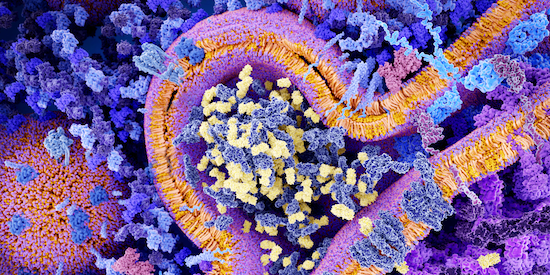Technological innovation leads to a deeper understanding of the natural world and the underlying causes of various diseases. Each year, new technologies and techniques help researchers to further elucidate the mechanisms of disease, allowing us to peer deeper inside our cells and tissues, and enabling a more complete picture of how life’s building blocks fit together.
In 2022, even as the COVID-19 pandemic continued to dominate headlines, the biotechnology field witnessed another year of rapid innovation. Spurred by the success of the SARS-CoV-2 vaccine, mRNA-based immunotherapies and vaccines made rapid progress, with the global market expected to reach $37.76 billion USD by 2030.
At the same time, advances in single-cell methodologies are facilitating the exploration of cellular heterogeneity in more detail than ever before. Moving beyond the bulk analyses and “average genome” or “average transcriptome” output of traditional approaches, advances in next-generation sequencing (NGS), microfluidics, computational biology, antibody-conjugation technologies, and amplification methodologies are converging to produce single-cell omics that interrogate RNA, protein, and post-translational protein modifications in disease-specific cells, even within a genetically identical cell population.
Combined with the spatial biology revolution, which allows scientists to study cellular relationships in the context of whole tissues, these technologies offer a more in-depth understanding of cellular interactions, disease progression, and treatment response.
To wade through these seismic shifts and shed light on the technological advances and treatment modalities that will be big in the coming years, I sat down with a few of the top research scientists at CST to hear their take. Here’s what they had to say:
Advances in Spatial Biology
“Spatial biology puts single-cell omics in spatial context and is transforming our understanding of the tissue microenvironment. New instruments are making previously impossible experiments possible, allowing us to explore spatial context in tissues through multiplexed biomarker analysis. Current challenges for scientists in this field include the extensive time and resources required to design, optimize, run, and analyze multiplexed imaging experiments. Advances in automated microfluidics for tissue staining combined with sophisticated imaging capabilities and computational tools are accelerating our ability to perform and interpret spatial biology experiments.
As these systems continue to mature, the dream is a multi-omics approach that integrates spatial proteomics data with spatial transcriptomics to achieve single-cell resolution across whole tissues. In 2023 and beyond, we’ll see new technologies for spatial biology that will allow scientists to quantify and visualize hundreds of phenotypic and functional biomarkers in tissue samples while maintaining cellular and sub-cellular detail.”
- Sarah Klein, PhD, Senior Scientist, Group Leader
The Immuno-Oncology Revolution
“There have been major advances in immuno-oncology over the past couple of years, and the revolution is continuing. We are gaining a better understanding of why immunotherapies sometimes fail, as well as the mechanisms that regulate T cell state and function. There is a sense of optimism and signs of potential success in applying this information to design better therapies.
 Adoptive cell therapy, particularly CAR-T therapy, continues to be a big focus for the field. One area of opportunity is to apply what is known about mechanisms that regulate T cell function and exhaustion to genetically modify T cells when they're outside of the patient. In theory, this could enable the cells to resist the suppressive mechanisms within the tumor microenvironment resulting in cell therapies that can function for a longer time within the solid tumors. I think we’ll see an increased focus on novel approaches for genetically engineering T cells to improve their effectiveness in solid tumors in the year ahead.
Adoptive cell therapy, particularly CAR-T therapy, continues to be a big focus for the field. One area of opportunity is to apply what is known about mechanisms that regulate T cell function and exhaustion to genetically modify T cells when they're outside of the patient. In theory, this could enable the cells to resist the suppressive mechanisms within the tumor microenvironment resulting in cell therapies that can function for a longer time within the solid tumors. I think we’ll see an increased focus on novel approaches for genetically engineering T cells to improve their effectiveness in solid tumors in the year ahead.
This year, the US Food and Drug Administration also approved the first therapy targeting LAG-3, which is an immune checkpoint that can negatively regulate the function of T cells. It’s been several years since the FDA approved the first therapies for the immune checkpoints, PD-1 and CTLA-4, so the approval of a third immune checkpoint is significant. In addition, there continue to be some exciting clinical trial results related to PD-1, for example, in the context of mismatch repair-deficient locally advanced rectal cancer. Overall, there's still a lot happening in the checkpoint field, and I expect we’ll see more to come over the next few years.”
-
Emily Alonzo, PhD, Director of Antibody Discovery, Immunology and Immuno-Oncology
Targeted Protein Degradation to Treat Previously “Undruggable” Targets
“Targeted Protein Degradation (TPD) is a field that we’re watching and are excited about. TPD is a potential therapeutic strategy that utilizes a novel class of drugs designed to co-opt existing protein degradation pathways to selectively destroy disease-causing proteins. It has the potential to target disease-causing proteins that were previously thought to be undruggable, allowing expansion beyond small-molecule inhibitors. For example, KRAS, mutations of which are linked with about 25% of all cancers, may no longer be considered an undruggable oncogene using TPD.
We’re still at the very beginning of TPD, however, and new breakthroughs will be needed to enable safe and effective clinical treatments. It will be interesting to see how this emerging technology will allow researchers to get past the pitfalls of prior methods and allow ‘out of the box’ thinking to target diseases in new, previously impossible ways.”
- Antony Wood, PhD, Senior Director, Product Design and Strategy
Single-Cell Sequencing, AI & Deep Learning
The single-cell space has revolutionized how we do biology—today, it’s nearly impossible to get published in the main journals without conducting single-cell experiments. While single-cell RNA sequencing (scRNA-seq) dominates current research, I believe that we’ll see the space continue to develop with more focus placed on single-cell proteomics (SCP), since it is, of course, at the level of protein activity that various disease states come into focus. While single-cell proteomics is not yet a widespread reality, higher resolution and higher sensitivity will allow single-cell studies to move beyond nucleic acids and provide a deeper understanding and characterization of proteome dynamics—especially when combined with quantitative analysis.
This goes hand-in-hand with advances in AI and deep learning (DL). These computational tools are redefining our ability to analyze large-scale data sets, providing a way to contextualize what we’re discovering about the underlying genetic, epigenetic, epitranscriptomic, and proteomic makeup of individual patients. It is now possible to not only apply DL to predict if a patient will respond to a certain drug and optimize dosing, but also to develop personalized treatments. We’re starting to see this play out with the resurgence of cancer vaccines. An initially promising therapeutic approach that died out in the 2010s, the flood of mRNA research resulting from the COVID-19 pandemic, combined with next-generation sequencing, is allowing researchers to predict, design, and create neoantigen vaccines that are personalized to a patient’s specific tumor.
Due to these innovations, the paradigm of ‘From the bench to the bedside and back’ is even more relevant than it was before. As researchers develop a better understanding of what’s happening in an individual patient, we’re gaining a clearer picture of disease heterogeneity and variations in the mechanisms of disease. By adjusting the therapy or designing a new one, not only can researchers create a personalized treatment that’s more likely to work for the individual patient being studied, but by targeting novel mechanisms of disease, we’re potentially unlocking a novel treatment mechanism that could work for additional patients with similar proteomic, epigenetic, and epitranscriptomics profiles.
-
Roby Polakiewicz, PhD, Chief Scientific Officer
Biotech Innovation in 2023 and Beyond
There comes a point where the culmination of various technological advances reaches a turning point—the pieces fall into place, and new avenues for research open up. We witnessed this in the early 2010s with the discovery of CRISPR, and we’re arguably at the forefront of another such apex. Computational developments are allowing us to make sense of the influx of data gathered from new and refined technologies such as spatial biology and single-cell omics.
There’s no doubt that there’s a lot happening in the biotechnology space, and it would be impossible to fit it all here. That being said, these topics summarize some of the key areas that we expect will continue to evolve and grow in the coming years.
What trends and technologies are you keeping on your radar?


